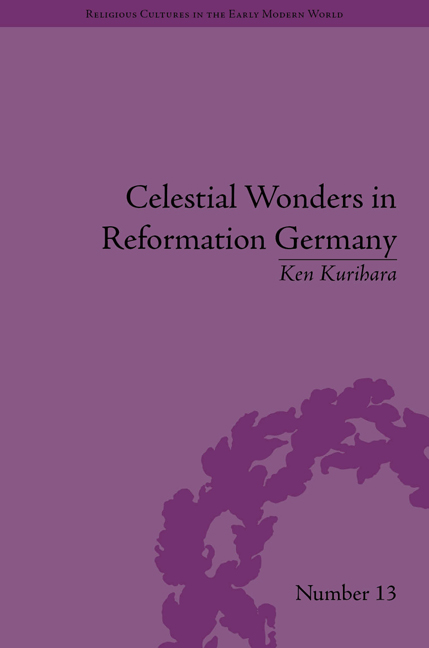Book contents
- Frontmatter
- CONTENTS
- Acknowledgements
- List of Figures
- Introduction: Celestial Wonders, Confessional Conflicts and Apocalypticism
- 1 Exploring the World of Wunderzeichen
- 2 Lutheran Clergy and Wunderzeichen Discourses
- 3 ‘An Eagle Hurting Himself’: Flacius's Tract against the Interim
- 4 Irenaeus against ‘Spiritual Wolves’: Polemical Use of Wunderzeichen, I
- 5 Irenaeus against the Concord: Polemical Use of Wunderzeichen, II
- 6 Andreae's Pastoral Use of Wunderzeichen
- 7 Celestial Wonders under the Shadow of War
- Conclusion
- Notes
- Works Cited
- Index
Introduction: Celestial Wonders, Confessional Conflicts and Apocalypticism
- Frontmatter
- CONTENTS
- Acknowledgements
- List of Figures
- Introduction: Celestial Wonders, Confessional Conflicts and Apocalypticism
- 1 Exploring the World of Wunderzeichen
- 2 Lutheran Clergy and Wunderzeichen Discourses
- 3 ‘An Eagle Hurting Himself’: Flacius's Tract against the Interim
- 4 Irenaeus against ‘Spiritual Wolves’: Polemical Use of Wunderzeichen, I
- 5 Irenaeus against the Concord: Polemical Use of Wunderzeichen, II
- 6 Andreae's Pastoral Use of Wunderzeichen
- 7 Celestial Wonders under the Shadow of War
- Conclusion
- Notes
- Works Cited
- Index
Summary
The Topic: Wunderzeichen
In sixteenth-century Germany, Wunderzeichen (‘wonder-signs’) could signify all kinds of wondrous phenomena observed in nature. According to Michaela Schwegler, the category of Wunderzeichen includes wonders that appeared in the sky, wonders related to grains (the raining of corn, or the miraculous finding of grains), wonders related to blood (the raining of blood, or blood which appeared in springs), and other kinds of mysterious incidents such as encounters with angels, prophetic children, ghostly apparitions and resurrections of the dead. Hiob Fincel's Wunderzeichen (1556), the pioneer of early modern books on wonders, includes not only these phenomena but also monstrous births, urban fires, natural disasters and terrible murders. However, in many cases the term Wunderzeichen was used to signify unusual celestial phenomena: comets, irregular movements of the sun and the moon (such as eclipses and halo phenomena), novae, Fewerzeichen (the Northern Lights), and apparitions of various strange objects such as rods (Rute), crosses, funeral processions, Christ, angels, armies of soldiers, and animals. In this study, my focus is limited to these wonders that appeared in the sky. People in Lutheran Germany in the sixteenth and the early seventeenth centuries showed great interest in these phenomena, and the sheer number of prints concerning strange celestial signs published during this period suggests their enormous popularity. Gustav Hellmann lists nearly four hundred titles (including reprints) of celestial Wunderzeichen broadsheets and tracts which appeared between 1550 and 1599. Yet these pieces are only a portion of the literature on this topic.
- Type
- Chapter
- Information
- Celestial Wonders in Reformation Germany , pp. 1 - 12Publisher: Pickering & ChattoFirst published in: 2014



